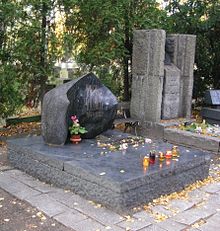This is an old revision of this page, as edited by Piotrus (talk | contribs) at 00:01, 5 August 2007. The present address (URL) is a permanent link to this revision, which may differ significantly from the current revision.
Revision as of 00:01, 5 August 2007 by Piotrus (talk | contribs)(diff) ← Previous revision | Latest revision (diff) | Newer revision → (diff)- For WOLA, see ].
Wola is a district in western Warsaw, Poland, formerly the village of Wielka Wola, incorporated into Warsaw in 1916. An industrial area with traditions reaching back to the early 19th century, it's slowly changing into an office and residential district. Several museums are located in Wola.
History
First mentioned in the 14th century, it became the site of the free elections, from 1573 to 1764, of Polish kings by the szlachta (nobility) of the Polish-Lithuanian Commonwealth.
The Wola district later became famous for the Polish Army's defence of Warsaw in 1794 during the Kościuszko Uprising and in 1831 during the November Uprising, when Józef Sowiński and Józef Bem defended the city against tsarist forces.
During the Warsaw Uprising (August-October 1944), fierce battles raged in Wola. Around August 8, Wola was the scene of the largest single massacre in Poland of 40,000 to 50,000 civilians.
Neighbourhoods

Wola is informally divided into Czyste, Koło, Mirów, Młynów, Nowolipki, Odolany, Powązki and Ulrychów neighbourhoods, which in many cases correspond to old villages or settlements, but nowadays have no official status.


This Warsaw-related location article is a stub. You can help Misplaced Pages by expanding it. |
| Inner city districts |
| ||||||||||||||||||||||
|---|---|---|---|---|---|---|---|---|---|---|---|---|---|---|---|---|---|---|---|---|---|---|---|
| Outer city districts |
| ||||||||||||||||||||||
| Related | |||||||||||||||||||||||